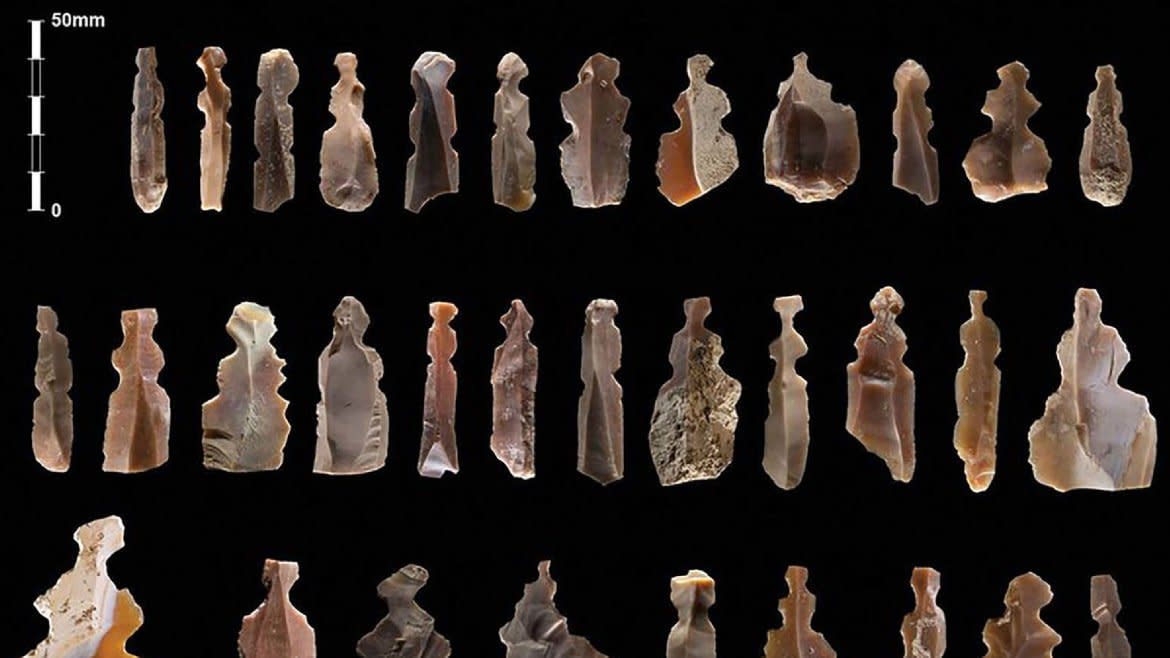What's With Our Obsession With Depicting People After They Die?

Archaeologists excavating near Amman, Jordan, have discovered a collection of over a hundred flint objects from 10,000 years ago. The hypothesis, initially dismissed as confusion brought on by sunstroke, would revolutionize our understanding of Neolithic artwork and, potentially, provide some of the earliest evidence for ancient ancestor worship.
The group of Spanish researchers, led by Juan Ibáñez of the Milà y Fontanals Institution of the Spanish National Research Council, were digging at Kharaysin when they came across the roughly two inch-long figures. Ibáñez and his team published his results in the journal Antiquity. When the first few figurines were discovered, a member of the team suggested that perhaps they were humanoid figures, a proposal that was met with much laughter. Ibáñez reported to Tom Metcalfe that, “The team reacted… with jokes about how much sun he had received on his head.” But as more and more figurines were unearthed, the suggestion became increasingly plausible.
The flint images themselves aren’t much to look at: they are shaped like lumpy violins. Flint was commonly used during the Neolithic period to make weapons and tools, but a lack of wear and tear on these objects suggests that they were never put to any kind of practical utilitarian use. Similarities with another cache of more obviously human figurines from nearby ‘Ain Ghazal have led the research team to conclude that they are representations of human bodies. The fact that the figurines were found close to burial sites suggests that the human figures “were manufactured and discarded during mortuary rituals and remembrance ceremonies that included the extraction, manipulation and redeposition of human remains.”
The article goes on to speculate that perhaps the flint figures are representations of the recently deceased and, thus, formed part of a previously unknown and remarkably early ancestor cult. The display and memorialization of deceased relatives using their image is common from antiquity into the present. Death masks—plaster, papier-mâché, or bronze molds of a person’s face made shortly are death— are a feature in many cultures. Extant examples include famous mummy masks like that of the Pharaoh Tutankhamun, masks of British royalty like Henry VII, French emperors (Napoleon) and philosophers (Pascal and Voltaire), Soviet dictators (Stalin), and Italian poets (Dante).
One particular death mask, L’inconnue de la Seine (Unknown woman of the Seine), made a superstar out of a Jane Doe. It was made from the body of an unidentified French teenager who drowned in the Seine in the late 1880s. The girl’s beauty inspired a generation of artists and imitators as copies of her mask were mass-produced and hung on the walls of fashionable Parisians. In the interwar period thousands of postcards with her image were in circulation. Apparently, a generation of young women (including several well-known German actresses) strove to emulate her “look.” A remarkable feat for a woman that one observer identified as a “peasant girl…[or] vagrant” She was compared to Mona Lisa and served as a muse for Picasso and Camus. If you can look past the slightly necrophile undertones, you can, to this day, buy hand-crafted copies of her death mask at L’Atelier Lorenzi.
For Victorian Britons, however, there was a more cutting-edge technology available. Photography proved a particularly popular form of memorializing one’s loved ones. The recently deceased were often posed as if they were sleeping or in a group shot with other family members. If you notice a child with their eyes closed in a line-up of Victorian siblings, chances are that that particular child was already dead when the photograph was made. That Victorian-era photography needed such long exposure made the dead ideal candidates for a portrait: they simply didn’t move and blur the image. Common family scenes include children with their deceased mother and parents holding recently deceased infants. In almost every case the images of the dead person are much sharper than those of the living. Given the cost of photography, for many subjects this would have been the first and only time that their photograph was taken.
Today, post-mortem photography continues in various places around the world including India, where these photographs often serve as legal proof of death for banks, and the United States, when families experience the loss of an infant. The iPhone means that anyone can be a death photographer, even if a recent article showed that people are often more comfortable with images of dead strangers than dead relatives.
If all of these practices, and their Neolithic 2-inch counterparts, seem a bit macabre, bear in mind that things could be worse: one could be a famous dead person. As Bess Lovejoy writes in her book Rest in Pieces, there’s a market for famous corpses. Whether the dead person is a famous saint or an acclaimed musician there’s a good chance that their remains will be dug up, divided, stolen, sold, and put on display. Though Albert Einstein expressed his desire to be cremated after death, Thomas Harvey (the pathologist who performed the autopsy on him) kept his brain in a jar and carried it with him as he moved from position to position. Philadelphia’s Mütter museum has 46 slides of Einstein brain tissue on display.
Thus, while the Jordanian flint figures may not be the most anatomically accurate mementos of deceased family members, maybe that’s a relief.
Get our top stories in your inbox every day. Sign up now!
Daily Beast Membership: Beast Inside goes deeper on the stories that matter to you. Learn more.

